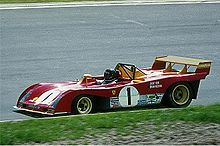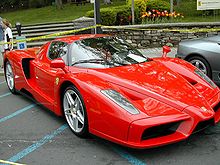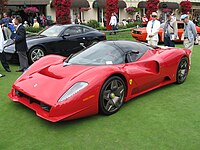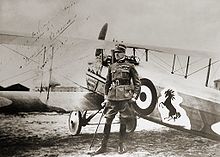ini gan ane kasih sejarahnya ferrari...
Main article: History of Ferrari
Enzo Ferrari never intended to produce road cars when he
formed Scuderia Ferrari (literally "Ferrari Stable", and usually used to mean "Team Ferrari", it is correctly pronounced [skudeˈria] "skoo-deh-REE-ah") in 1928 as a sponsor for amateur drivers headquartered in Modena. Ferrari prepared, and successfully raced, various drivers in Alfa Romeo cars until 1938, when he was hired by Alfa Romeo to head their motor racing department.[edit] Motorsport
[edit] Scuderia Ferrari
[edit] Race cars for other teams
[edit] Road cars
[edit] Supercars
[edit] Concept cars and specials
[edit] Bio-fuel and hybrid cars
[edit] Naming conventions
- V6 and V8 models used the total displacement (in decilitres) for the first two digits and the number of cylinders as the third. Thus, the 206 was a 2.0 L V6 powered vehicle, while the 348 used a 3.4 L V8, although, for the F355, the last digit refers to 5 valves per cylinder. Upon introduction of the 360 Modena, the digits for V8 models (which now carried a name as well as a number) refer only to total engine displacement. The numerical indication aspect of this name has carried on to the current V8 model, the F430. The F430's replacement, however, is the 458 Italia, which uses the same naming as the 206 and 348.
- V12 models used the displacement (in cubic centimetres) of one cylinder. Therefore, the famed 365 Daytona had a 4390 cc V12. However, some newer V12-engined Ferraris, such as the 599, have three-number designations that refer only to total engine displacement.
- Flat 12 (boxer) models used the displacement in litres. Therefore, the BB 512 was five litre flat 12 (a Berlinetta Boxer, in this case). However, the original Berlinetta Boxer was the 365 GT4 BB, which was named in a similar manner to the V12 models.
- Halo Car F followed by the anniversary in years, such as the F40 and F50. The Enzo skipped this rule, but it will return in the upcoming F70.
- Some models, such as the 1980 Mondial and the 1984 Testarossa did not follow a three-number naming scheme.
- M ("Modificata"), placed at the end of a model's number, denotes a modified version of its predecessor and not a complete evolution (see F512 M and 575 M Maranello).
- GTB ("Gran Turismo Berlinetta") models are closed Berlinettas, or coupes.
- GTS ("Gran Turismo Spyder") in older models, are open Spyders (spelt "y"), or convertibles (see 365 GTS/4); however, in more recent models, this suffix is used for targa top models (see Dino 246 GTS, and F355 GTS; the exception being the 348 TS, which is the only targa named differently). The convertible models now use the suffix "Spider" (spelt "i") (see F355 Spider, and 360 Spider).
- GTO ("Gran Turismo Omologata"), placed at the end of a model's number, denotes a modified version of its predecessor. Indeed, those three letters designate a model which has been designed and improved for racetrack use while still being a street-legal model. Only three models bear those three letters; the 250 GTO of 1962, the 288 GTO of 1984 and more recently the 599 GTO of 2010 with its 671 horsepowers.
[edit] Identity
[edit] Colour
[edit] Corporate affairs
[edit] Technical partnerships


























0 komentar:
Posting Komentar